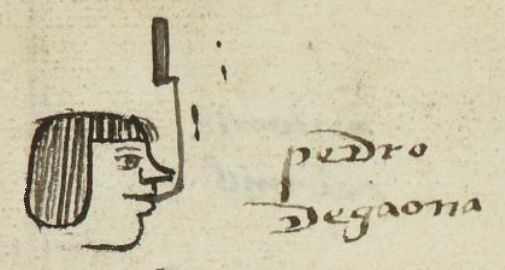de Gaona (MH622r)
This simplex glyph for the European last name, de Gaona, shows a vertical, narrow, rectangle, painted black.
Stephanie Wood
The meaning of the glyph is something of a puzzle. This may be an obsidian blade, which is usually itztli, but it could also be a tetl (stone), with the "te-" standing in phonetically for the "de." Gaona does not appear to be represented visually.
The name "de Gaona" probably comes from an admiration for Fray Juan de Gaona, a Franciscan friar who came to New Spain in 1538 and died in 1560. He put together colloquios in Nahuatl, a publication that came out after his death.
Stephanie Wood
peDro
Degaona
Pedro de Gaona
Stephanie Wood
1560
Jeff Haskett-Wood
piedra, nombres de hombres, nombres españoles, nombres prestados

de Gaona
Matrícula de Huexotzinco, folio 622r, World Digital Library, https://www.loc.gov/resource/gdcwdl.wdl_15282/?sp=326st=image.
This manuscript is hosted by the Library of Congress and the World Digital Library; used here with the Creative Commons, “Attribution-NonCommercial-ShareAlike 3.0 License” (CC-BY-NC-SAq 3.0).





